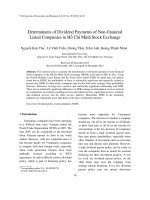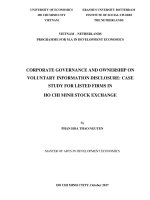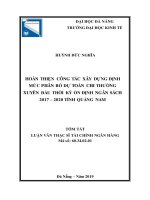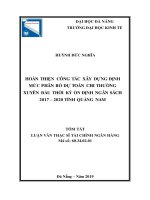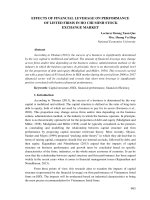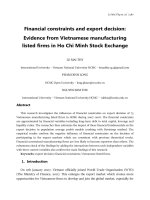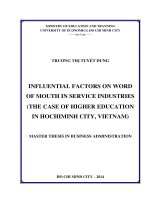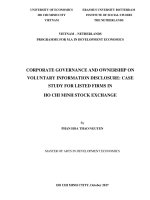Factors impacting on abnormal investment of listed firms in ho chi minh stock exchange luận văn thạc sĩ tài chính ngân hàng
Bạn đang xem bản rút gọn của tài liệu. Xem và tải ngay bản đầy đủ của tài liệu tại đây (1.86 MB, 125 trang )
MINISTRY OF EDUCATION AND TRAINING STATE BANK OF VIETNAM
BANKING UNIVERSITY OF HO CHI MINH CITY
KIEU CONG BAO TRAN
FACTORS IMPACTING ON ABNORMAL INVESTMENT
OF LISTED FIRMS IN HO CHI MINH STOCK EXCHANGE
MASTER'S THESIS
Ho Chi Minh City - 2020.
MINISTRY OF EDUCATION AND TRAINING STATE BANK OF VIETNAM
BANKING UNIVERSITY OF HO CHI MINH CITY
KIEU CONG BAO TRAN
FACTORS IMPACTING ON ABNORMAL INVESTMENT
OF LISTED FIRMS IN HO CHI MINH STOCK EXCHANGE
Major: Finance and Banking
Code : 8340201
MASTER'S THESIS
ACADEMIC ADVISOR: PhD. TRAN ANH TUAN
Ho Chi Minh City – 2020.
i
DECLARATION
I hereby declare that this master thesis entitled “FACTORS IMPACTING ON
ABNORMAL INVESTMENT OF LISTED FIRMS IN HO CHI MINH STOCK
EXCHANGE” is the result of my own original research work under the guidance of
Mr. Tuan Anh Tran, my thesis advisor.
This thesis has never been submitted for a master's degree at any other universities.
This thesis is the author's own research and the results of the research are trustworthy.
The thesis does not consist of any previously published content or content made by
others except for citations which are fully cited in the thesis.
Ho Chi Minh City, September..., 2020
KIEU CONG BAO TRAN
ii
ACKNOWLEDGEMENTS
Apart from the efforts of myself, the completion of this thesis depends largely on the
help, encouragement and guidelines of many others. I shall take this opportunity to
show my gratitude to the people who have been instrumental in this accomplishment
of the thesis.
I would like to express my special appreciation and thanks to my academic advisor
Mr. Tuan Anh Tran for his tremendous support and help as well as for his patience,
enthusiasm, and immense knowledge. Without his guidance, this project would not
have materialized.
Furthermore, I would like to give my sincere thanks to Banking University of Ho Chi
Minh City for giving me the opportunity to do this research and to all the lecturers
there who have imparted the useful knowledge and practical experiences over the
last one year.
For the greatest thing, a special thanks to my dearest family is indispensable. Words
cannot express how grateful I am to my mother, my father, my sister and brother for
all of the sacrifices that you have made on my behalf. Your prayers for me were what
sustained me thus far. I could not have done it without you. Also, I would like to
thank all of my friends who supported me in writing and incented me to strive
towards my goal.
Thank you.
KIEU CONG BAO TRAN
iii
ABSTRACT
Title: FACTORS IMPACTING ON ABNORMAL INVESTMENT OF LISTED
FIRMS IN HO CHI MINH STOCK EXCHANGE.
Abstract: The purpose of the thesis is to study factors impacting on abnormal
investment in Vietnam, namely that factors are free cash flow and dividends. To
achieve the main purpose, the study aims to first classify abnormal investment into
two categories, over- and under-investment, by using an accounting-based
framework developed by Richardson (2006) and Guariglia and Yang (2016).
Secondly, by defining overinvestment as investments in negative NPV projects
exceeds firm needs and underinvestment as the act of passing positive NPV
investments essential for firm growth, the study relates these two categories of
abnormal investment to firm’s free cash flow corresponding to financial constraints
and agency problems theory. Finally, the study examines the influence of dividends
on overinvestment. The studying data consists of 306 non-financial listed firms in
Ho Chi Minh Stock Exchange with 3,672 firm-year-observations over the period
2008–2019. The study employs a proper research process with system GMM and
FEM with clustered standard errors as final methods for conclusions. The findings
documented strong evidence of investment inefficiency exists among Vietnamese
listed firms, which can be explained by financing constraints and agency problems.
Specifically, the results showed that firms with free cash flow below (above) their
optimal level tend to under-(over-) invest as a consequence of financial constraints
(agency costs). Moreover, the results indicated that dividends could increase
investment efficiency. Taking these findings into account, both corporate governance
practices and financial market need taking actions to improve investment efficiency
in Vietnamese firms. Also, the findings support existing literature and become a
foundation for further researches in investment inefficiency.
Keywords: Abnormal investment, free cash flow, dividend, financial constraints,
agency cost.
iv
ABSTRACT (VIETNAMESE)
Tiêu đề: CÁC NHÂN TỐ TÁC ĐỘNG ĐẾN ĐẦU TƯ BẤT THƯỜNG CỦA
NHỮNG CÔNG TY NIÊM YẾT TRÊN SỞ GIAO DỊCH CHỨNG KHỐN
THÀNH PHỐ HỒ CHÍ MINH.
Tóm tắt: Mục tiêu của luận văn là nghiên cứu các nhân tố tác động đến đầu tư bất
thường ở các doanh nghiệp Việt Nam, cụ thể là nhân tố dòng tiền tự do và cổ tức. Để
đạt được mục tiêu, đầu tiên nghiên cứu phân đầu tư bất thường thành hai loại: đầu tư
quá và dưới mức, bằng cách sử dụng mô hình phân tích của Richardson (2006) và
Guariglia and Yang (2016). Thứ hai, bằng việc định nghĩa đầu tư quá mức là những
khoản đầu tư kể cả vào các dự án có NPV âm vượt q nhu cầu cơng ty và đầu tư
dưới mức là hành động phải cắt giảm các dự án có NPV dương cần thiết cho sự tăng
trưởng công ty, nghiên cứu đã liên kết hai loại đầu tư bất thường này với dịng tiền
tự do của cơng ty tương ứng theo lý thuyết hạn chế tài chính và chi phí đại diện. Cuối
cùng, nghiên cứu xem xét ảnh hưởng của cổ tức đối với việc đầu tư quá mức. Dữ liệu
nghiên cứu bao gồm 306 doanh nghiệp phi tài chính được niêm yết trên Sở Giao dịch
Chứng khốn Thành phố Hồ Chí Minh với 3.672 quan sát trong giai đoạn 2008-2019.
Nghiên cứu được thực hiện theo trình tự phù hợp với ước lượng system GMM và mơ
hình FEM with clustered standard errors làm phương pháp cuối cùng để đưa ra kết
luận. Kết quả nghiên cứu cho thấy những bằng chứng cụ thể về sự kém hiệu quả
trong đầu tư tồn tại giữa các doanh nghiệp niêm yết tại Việt Nam, điều này có thể
được giải thích bởi sự hạn chế về tài chính hay việc gặp vấn đề về chi phí đại diện.
Cụ thể, các cơng ty có dịng tiền tự do dưới (trên) mức tối ưu có xu hướng đầu tư
dưới (quá) mức do bị hạn chế tài chính (gặp vấn đề về chi phí đại diện). Ngồi ra,
kết quả cịn cho thấy cổ tức có thể làm tăng hiệu quả đầu tư. Khi xem xét những kết
quả này, cần có những phương án cho việc áp dụng thực hiện các quy định về quản
trị công ty và thị trường tài chính để nâng cao hiệu quả đầu tư tại các doanh nghiệp
Việt Nam. Hơn nữa, những kết quả này còn hỗ trợ cho các lý thuyết hiện hữu và có
thể trở thành nền tảng cho các nghiên cứu sau về vấn đề kém hiệu quả trong đầu tư.
Từ khóa: Đầu tư bất thường, dịng tiền tự do, cổ tức, hạn chế tài chính, chi phí đại
diện.
v
LIST OF ABBREVIATIONS
Abbreviations
Definition
3SLS
Three-Stage Least Squares Regression
FEM
Fixed-effects model
HOSE
Ho Chi Minh City Stock Exchange
NPV
Net Present Value
OLS regression
Ordinary Least Squares Regression
REM
Random-effects model
ROA
Return on Assets
System-GMM
System-Generalized Method of Moments
vi
TABLE OF CONTENTS
DECLARATION .................................................................................................. i
ACKNOWLEDGEMENTS ................................................................................ ii
ABSTRACT ........................................................................................................ iii
ABSTRACT (VIETNAMESE).......................................................................... iv
LIST OF ABBREVIATIONS ............................................................................. v
TABLE OF CONTENTS ................................................................................... vi
LIST OF TABLES.............................................................................................. ix
LIST OF EQUATIONS AND FIGURES .......................................................... x
CHAPTER 1: INTRODUCTION ..................................................................... 1
1.1. Introduction and Background.......................................................................... 1
1.2. Research gap identification and new contributions ........................................ 3
1.3. Research objectives ......................................................................................... 4
1.4. Research questions .......................................................................................... 5
1.5. The scope of the study .................................................................................... 6
1.6. Research data and Methodology ..................................................................... 6
1.6.1. Research data .............................................................................................. 6
1.6.2. Methodology ............................................................................................... 6
1.7. Research structure ........................................................................................... 8
CHAPTER 2: LITERATURE REVIEW ........................................................ 9
2.1. Theoretical Framework ................................................................................... 9
2.1.1. Pecking - order theory ................................................................................. 9
2.1.2. Financial constraints theory ...................................................................... 10
2.1.3. Agency problems theory – Free cash flow theory .................................... 11
vii
2.2. Free cash flow ............................................................................................... 12
2.3. Dividends ...................................................................................................... 13
2.4. Abnormal investment and measurement framework .................................... 13
2.4.1. Financial constraints with free cash flow-underinvestment relationship . 16
2.4.2. Agency problems with free cash flow-overinvestment relationship ........ 18
2.4.3. The relationship between dividends and overinvestment ......................... 20
2.5. The previous researches ................................................................................ 21
2.6. Hypotheses for models .................................................................................. 26
2.6.1. Hypotheses for research question 1 .......................................................... 26
2.6.2. Hypothesis for research question 2 ........................................................... 27
CHAPTER 3: RESEARCH METHODOLOGIES....................................... 29
3.1. Data, Sample and Variables .......................................................................... 29
3.2. Research Models ........................................................................................... 32
3.2.1. Expectation model for firm investment expenditure decision level ......... 32
3.2.2. The relationship between free cash flow and abnormal investment level 36
3.2.3. The relationship between dividends and overinvestment ......................... 37
3.3. Research methods ......................................................................................... 40
3.3.1. Descriptive statistics ................................................................................. 40
3.3.2. Estimation methods................................................................................... 41
3.3.3. Research process ....................................................................................... 43
CHAPTER 4: EMPIRICAL RESULTS ........................................................ 45
4.1. Descriptive statistics ..................................................................................... 45
4.2. Correlation matrix ......................................................................................... 49
4.3. Regression analysis by REM and FEM ........................................................ 50
4.3.1. Expectation model for firm investment expenditure decision level ......... 50
viii
4.3.2. The relationship between abnormal investment level and free cash flow 52
4.3.3. The relationship between cash dividend payout and overinvestment ...... 53
4.4. Test of consistent and unbiased .................................................................... 55
4.5. FEM with clustered standard errors, System-GMM results and discussion . 57
4.5.1. System-GMM test for model 1 ................................................................. 57
4.5.2. FEM with clustered standard errors for model 2.1 and 2.2 ...................... 60
4.5.3. System-GMM test for model 3 ................................................................. 61
4.6. Empirical evidence of over–and under–investing Vietnamese firms ........... 63
CHAPTER 5: CONCLUSIONS AND POLICY IMPLICATIONS............ 65
5.1. Findings ......................................................................................................... 65
5.2. Implications ................................................................................................... 66
5.2.1. Implications to companies ........................................................................ 66
5.2.2. Implications to policy makers ................................................................... 69
5.3. Limitations .................................................................................................... 70
CONCLUSION .................................................................................................. 71
REFERENCES ..................................................................................................... i
APPENDIX ........................................................................................................ xv
ix
LIST OF TABLES
Table 4.1. Sample means and medians ....................................................................46
Table 4.2. Extended analysis of investment expenditure .........................................51
Table 4.3. Under- or over- investment and free cash flow sensitivities in model 2.1
and 2.2 ......................................................................................................................53
Table 4.4. The relationship between dividend payout and overinvestment .............54
Table 4.5. Hausman test for choosing model ...........................................................55
Table 4.6. Heteroskedasticity, Autocorrelation, Endogeneity Test .........................56
Table 4.7. Extended analysis of investment expenditure .........................................59
Table 4.8. Under- or over- investment and free cash flow sensitivities in model 2.1
and 2.2 ......................................................................................................................61
Table 4.9. The relationship between dividend payout and overinvestment .............62
Table 4.10. Results of residual model determining firm investment level ..............64
x
LIST OF EQUATIONS AND FIGURES
Equation
Equation 3.1 ..............................................................................................................41
Equation 3.2 ..............................................................................................................41
Equation 3.3 ..............................................................................................................42
Figures
Figure 2.1. Pecking-order theory ................................................................................ 9
Figure 3.1. Framework for the construction of under- and over- investment ..........31
Figure 3.2. Framework for Free Cash Flow .............................................................31
Figure 3.3. Steps in research process .......................................................................44
Figure 4.1. Four firm groups based on their abnormal investment and free cash flow.
..................................................................................................................................45
1
CHAPTER 1: INTRODUCTION
This chapter contains an introduction to this topic. First, in section 1.1, the research
introduction and background is described. Section 1.2 contains the research gap
identification and new contributions; section 1.3, 1.4 and 1.5 discuss about the
research objectives, questions and the scope of the study. Subsequently, the research
data and methodology are indicated in section 1.6. The last section (section 1.7) of
this chapter contains the structure of this thesis.
1.1. Introduction and Background
Investment is an indispensable tasks and activities, undertaken by company to
achieve defined economic or financial goals. Investment efficiency is an important
driving factor in project evaluation as it affects the growth of company, company’s
future cash flow and plays a significant role in increasing company’s value.
Therefore, a relatively large concentration about factors impacting this efficiency
have been researched. Problems such as of information asymmetry between
management and financial institutions, and agency conflicts between controlling
shareholders and minority investors, as well as between management and
shareholders have been found to significantly influence firms' investment decisions
(Abhyankar, Ho, & Zhao*, 2005; S. Fazzari, Hubbard, & Petersen, 1987; Jensen,
1986; Jiang, Lee, & Yue, 2010; Myers & Majluf, 1984). These problems induce the
inefficiency of investment and are particularly appeared in emerging market. Based
on the ideal conditions such as current position as an emerging economy in Asia,
having a weak form market efficiency (Vo & Phan, 2017) as well as insufficient
capital and equity markets (Phan, 2018) and poor corporate governance practice (Van
Tuan & Tuan, 2016), Vietnam becomes a perfect laboratory to study firms’
investment efficiency in the presence of both financial constraints and agency
problems. This would lead to abnormal investment decisions that brings inefficiency
and harmfulness to the country’s companies.
Investment inefficiency can cause firms to lose growth opportunities by passing out
many positive NPV investment projects, which is called under-investing, or can
2
waste firms’ time and money by having excessive investments even with negative
NPV projects, which is called over-investing. Under- and over-investment are
referred as abnormal investment (Guariglia & Yang, 2016). Extant researches have
evidenced the existence of abnormal investment in many countries such as U.S,
China, Brazil and Singapore, etc. (Farooq, Ahmed, & Saleem, 2015; Guariglia &
Yang, 2016; Pellicani & Kalatzis, 2019; Richardson, 2006). Since abnormal
investment could bring harm to companies’ performance and relationship with
involved parties, number of researchers have investigated about factors that could
influence it to identify for its reasons and suggested that free cash flow are
significantly positive relate to it (S. Fazzari et al., 1987; Guariglia & Yang, 2016;
Jensen & Meckling, 1976; Richardson, 2006). Furthermore, many researches has
documented that the positive sensitivities of abnormal investment to free cash flow
rise in over-investing firms due to agency problems (Ding, Guariglia, & Knight,
2010; Francis, Hasan, Song, & Waisman, 2013; Moez & Amina, 2018; Pawlina &
Renneboog, 2005). While other researches have reported that these positive
sensitivities of abnormal investment to free cash flow increase in under-investing
firms as a consequence of financial constraints (Bassetto & Kalatzis, 2011; Carpenter
& Guariglia, 2008; S. Fazzari et al., 1987; Mulier, Schoors, & Merlevede, 2016;
Riaz, Shahab, Bibi, & Zeb, 2016). Some researches has indicated that higher positive
investment-cash flow sensitivities in both underinvesting firms facing financial
constraints and overinvesting firms suffering from agency problems compared to
other firms (Guariglia & Yang, 2016; Hovakimian & Hovakimian, 2009).
On the other hand, several studies attempted to find the solutions to abnormal
investment such as over-investment. Problems of overinvestment, the excessive
investment level compared to the expected level of investment need and might even
take negative NPV projects, makes a company's operation less efficient and effective.
López-de-Foronda, López-de-Silanes, López-Iturriaga, and Santamaría-Mariscal
(2019); Wei, Wang, and Guo (2019); Ali, Balachandran, Michael, and Theobald
(2019) have discovered that the payment of dividends require managers to make
efficient investment to increase profitability and fulfil their commitments to
3
shareholders. Therefore, it is stated that dividends plays a disciplinary role in firms
as dividend policy can moderate the overinvestment level due to the negative effects
of it on overinvestment. This has been supported by numerous studies in many
countries such as Rozeff (1982); Moin, Guney, and El Kalak (2019); Wei et al.
(2019); Crisóstomo, de Freitas Brandão, and López-Iturriaga (2020); etc.
In Vietnam, which has been seen as a developing market with fast-growing economy,
abnormal investment such as under- and over- investment has been found to appear
in listed firms by Le Ha Diem Chi and Chau (2019)and some other unofficial
researches. Moreover, Le Ha Diem Chi and Chau (2019) has pointed out the positive
relationship between free cash flow and overinvestment corresponded to agency
theory through the empirical results. Trong and Nguyen (2020) discovered that
dividend policy can moderate the negative effect of overinvestment on firm
performance. Because there are not many official and unofficial studies about the
reasons, mitigation solutions and determinants of abnormal investment, this
investment inefficiency problem still has not been fully concerned, especially in
Vietnam’s market situation. This reason have led the author to choose the topic
“FACTORS IMPACTING ON ABNORMAL INVESTMENT OF LISTED
FIRMS IN HO CHI MINH STOCK EXCHANGE” to research, which would
focus mainly on the impact of free cash flow and dividends on abnormal investment.
1.2. Research gap identification and new contributions
Relying on the results of previous researches, the author strongly believes that there
are still gaps about ideas and methods in research topic about abnormal investment
need further analysis. Therefore, the thesis devoted four main contributions to fill in
the gaps of existing studies.
First, the thesis have examined both under- and over- investment at the same time as
the author believe that these two types of abnormal investment are likely to coexist
in Vietnam due to its poor corporate governance practice (Van Tuan & Tuan, 2016)
and underdeveloped financial market with weak institutional quality and severe
information asymmetry (Trong & Nguyen, 2020). This is different from many others
4
official and unofficial researches in Vietnam such as Le Ha Diem Chi and Chau
(2019) as well as some studies in other countries such as Richardson (2006);
Franzoni (2009); Cai (2013); S. Fazzari et al. (1987), which only were considered to
investigate solely on one type of abnormal investment. By doing so, the thesis can
give conclusions to a wide variety of aspects of investment inefficiency problems.
Secondly, the thesis would show a proper research process with new different
approaches such as REM, FEM with clustered standard errors and System GMM for
the future studies of this topic in Vietnam. So far, official and unofficial Vietnamese
studies about the topic has adopted OLS regressions, dividing into different groups
by sized to analysis, two-steps GMM, logistic polynomial regression and Euler
equation regression, etc. (Le Ha Diem Chi & Chau, 2019; Trong & Nguyen, 2020).
Thirdly, the thesis focuses on the relationship between dividends and overinvestment
by directly regressing overinvestment value on dividends payout ratio unlike other
researches, which were regressing the marginal effect of dividend on
overinvestment (Trong & Nguyen, 2020) or regressing dividend payout ratio on
agency cost through average growth rate (Rozeff, 1982) or regressing dividends
payout ratio on overinvestment (Moin et al., 2019) or regressing growth
opportunities (market-to-book assets ratio) on dividend policy (Crisóstomo et al.,
2020). This method can help to find the direct relationship between those two factors
and consider whether dividends could be a method to restrict overinvestment as well
as raise the level of efficiency in investment.
Finally, the thesis may provide an updated analysis on the overinvestment problem
corresponding to agency theory in Vietnam with a fresh set of data including 3,672
firm-year observations in total of 306 non-financial listed firms on Ho Chi Minh
Stock Exchange (HOSE) during period 2008-2019.
1.3. Research objectives
The major objective of this study was to investigate to better understand the impact
of free cash flow and cash dividends on abnormal investment in different business
situation based on Vietnamese non-financial firms listed in Ho Chi Minh Stock
Exchange in the period 2008-2019.
5
The study attempts to examine the relationship as well as the sensitivity between
abnormal investment through the presence of both under- and over- investment
among Vietnamese listed firms and free cash flow. This objective was done by
adopting the framework proposed by Richardson (2006) and developed by Guariglia
and Yang (2016) to construct firm’s abnormal investment and free cash flow
measures. The result helps to shed light on whether investment inefficiency could be
explained by financial constraints and agency problems or not in order to make
appropriate conclusions under conditions of Vietnam’s environment. In particular,
the author aims to find if firms face financial constraints (agency problems) would
tend to have higher sensitivities and positive correlations of under- (over-)
investment to free cash flow below (over) their optimal level or not.
The second objective is to determine whether cash dividends could be considered as
a restrictive factor for overinvestment or not by researching on the impact of cash
dividends on overinvestment. From these results, appropriate policies could be
suggested and recommend to improve business investment decision making and
operations.
1.4. Research questions
In order to achieve the research objectives, the thesis seeks to address the following
three main research questions:
Research question 1.1: What is the impact of negative free cash flow on
underinvestment in listed firm in HOSE? Can this effect be considered as a
consequence of financial constraints?
Research question 1.2: What is the impact of positive free cash flow on
overinvestment in listed firm in HOSE? Can this effect be considered as a
consequence of agency problems?
Research question 2: What is the influence of cash dividends on over investment
caused by free cash flow in listed firm in HOSE?
6
1.5. The scope of the study
This research will investigate in 306 non-financial firms in manufacturing, services
industries in Ho Chi Minh Stock Exchange during the period 12 years from 2008 to
2019. The author select the 12-year-time from 2008 because this is the benchmark
year when Vietnam's stock market faced difficulties resulted in the global financial
crisis, then started to overcome and grow significantly for the next following year.
As a consequence of this, more companies is listed in the Stock Exchange as well as
the size of firms and market increases sufficiently which provides an idea laboratory
for this study. In addition, most of the data is available to access and easy to collect.
Only non-financial firms are being used because of the differences in features and
meanings for high level of leverage implied between financial and non-financial
firms, which could lead to biased results for using both.
1.6. Research data and Methodology
1.6.1. Research data
This thesis will use the secondary data collected from financial statements of 306
firms’ annually audited Consolidated Financial Statements from the year 2008 to
2019, such as net cash flow of investment activities, depreciation and amortization,
net cash flow generated by operating activities, dividends, firm characteristics, age,
other receivables, other payables, etc. Excluding financial firms and some
inappropriate firms in Ho Chi Minh Stock Exchange leave 3,672 firm-year
observations in total, but the exactly numbers in each analysis model are varies
depends on the situation. The sample has covered 89.21% of the companies and
approximately 70% of total Market capitalization in HOSE.
1.6.2. Methodology
Some approaches such as Ordinary Least Square (OLS) regression, Fixed effect
model (FEM) with or without Huber - White robust standard errors or clustered
techniques and Generalized Method of Moments (GMM) are commonly used to
examine the existence of abnormal investment by many studies of Richardson
(2006); Guariglia and Yang (2016); Franzoni (2009); Pellicani and Kalatzis (2019);
7
S. Fazzari et al. (1987) and are employed to investigate the relationship or sensitivity
between free cash flow and investment by researches of
Richardson (2006);
Guariglia and Yang (2016); Ding et al. (2010); X. Chen, Sun, and Xu (2016); S.
Fazzari et al. (1987); Mulier et al. (2016). Also, such frequent methods are adopted
to test the relationship between cash dividends and over – investment by some studies
of Trong and Nguyen (2020), Moin et al. (2019), Farooq, Gilbert, and Tourani-Rad
, Crisóstomo et al. (2020), then the robustness tests are carried out for checking the
consistency of those approaches. Although OLS regression is simply to use and
understand, the main disadvantages of it are limitations in the shapes that linear
models can assume over long ranges, possibly poor extrapolation properties, and
sensitivity to outliers, which could make unreliable results. Therefore, the author will
inherit and develop the methodology from previous research by applying Fixed and
Random-Effects Models (FEM and REM) for all the research models with panel data
because a major advantage of these models is provide a way to control for all timeinvariant unmeasured or latent variables that influence the dependent variable
whether these variables are known or unknown to the researcher (Bollen & Brand,
2010). The REM assumes that the omitted time-invariant variables are uncorrelated
with the included time-varying covariates while the FEM allows these variables to
freely correlate (Mundlak, 1978). Moreover, the REM has the advantage of greater
efficiency relative to the FEM leading to smaller standard errors of coefficients and
higher statistical power to detect effects (Hsiao, 2014). Next, a Hausman (1978)
test will be applied to choose consistent model between FEM and REM. By
employing these steps, the author could demonstrate the best fit model for the thesis
between two options. Then, diagnostic tests will be tested for models’ problems.
Finally, either System-Generalized Method of Moments (System-GMM) proposed
by Blundell and Bond (1998) and Blundell and Bond (2000) or FEM/ REM with
clustered standard errors would be used depending on the type and the presence of
research models’ problems. Their results would be taken to make final conclusion.
8
1.7. Research structure
The thesis has been organized in the following way.
Chapter 1 (Introduction) provides the overall background, brief description about
research gap and the reasons lead to this dissertation. Then, it shows the research
objectives and questions, research data and methodology.
Chapter 2 (Literature review) shows the framework theory, literature review,
definitions about the term which are used throughout the dissertation and some
previous researches. Then, it indicates about the hypotheses of each research models.
Chapter 3 (Research methodologies) first shows the information about data, sample
and variables of the research. Next, it presents the models for the three research
questions. Then, it describes the research methods and process, which would be
applied throughout this thesis.
Chapter 4 (Empirical results) depicts the results of models through each method and
gives the analysis, evaluation and make conclusions.
Chapter 5 (Conclusion and Policy implications) gives the findings, recommendations
and limitations of the study.
9
CHAPTER 2: LITERATURE REVIEW
This chapter contains an elaboration on the relevant literature and hypotheses in order
to frame this research. First, section 2.1 contains all theoretical framework that is
used throughout this study. Section 2.2, 2.3 and 2.4 indicate respectively the
literature review of the variables ‘Free cash flow’, ‘Dividends’ and ‘Abnormal
investment and measurement framework’. Subsequently, section 2.5 reviews the
results of the previous researches that signals the pathway for this study. Finally, the
hypotheses of this research are formulated in the last section (section 2.6).
2.1. Theoretical Framework
2.1.1. Pecking - order theory
Pecking order theory begins with asymmetric information (Myers & Majluf, 1984)
as managers know more about their companies’ internal information in many aspects
such as prospects, risks and value than outside investors do. Followed by this, the
theory suggests that firms have a particular preference order for capital used to
finance their businesses, which comes from three sources, internal funds, debt and
new equity. Myers and Majluf (1984); Hillier, Ross, Westerfield, Jaffe, and Jordan
(2010), Myers (2001) argues that due to the information asymmetries between the
firm and potential investors, firms have a preferred hierarchy for financing decisions,
hereinafter:
Figure 2.1. Pecking-order theory
Internally
Gernerated
Funds
Debt
New issuance
of equity
(Source: Kaplan Financial Knowledge Bank (2013), authors’ own illustration).
The selection of sources of financing depends on the preference order: retained
earnings to debt, short-term debt over long-term debt and debt over equity (Li, Chen,
& Wang, 2011) The internal funds such as retained earnings, free cash flow is used
first because it comes directly from the firm itself and has lowest information
asymmetry costs (Gaud, Jani, Hoesli, & Bender, 2005; Mazur, 2007; Mostafa &
Boregowda, 2014). Therefore, internal financing is the cheapest and most convenient
10
source of financing (Luigi & Sorin, 2009). As opposed to internal financing, external
financing such as debt or equity financing generates higher cost to firms to
compensate for information asymmetry when they decide to use this type of finance.
Debt holders require a lower return as opposed to stockholders because they are
entitled to a higher claim to assets in the event of a bankruptcy.
2.1.2. Financial constraints theory
Financial constraints theory starts with the definition from the study of Kaplan and
Zingales (1995) “A firm is financially constrained if the cost of availability of
external funds precludes the company from making an investment it would have
chosen to make had internal funds been available”. Asymmetric information suggests
that not all market participants have the same access to information (Kadapakkam,
Kumar, & Riddick, 1998) As regards empirical result, Berk and DeMarzo (2007)
states that managers have a privilege to know more internal financial information in
the company than the outsider investors, such as the financial situation of the firm.
Harbula (2001); Myers and Majluf (1984); Myers (1984) Brennan and
Subrahmanyam (1996); Easley and O'hara (2004) argues that when market
imperfections is presented into the traditional theories, which could be shown as
asymmetric information between borrowers and lenders, firms prefer internal
financing. Hence, the higher availability level of internal fund is, the higher
investment ability level that firms have, as the internal funds are the cheapest and
easiest for firm to access (S. M. Fazzari & Athey, 1987; Harbula, 2001).
Another explanation for the behaviour of usually using internal funds is that the
relationship with information asymmetry could limit a firm’s access to external funds
due to information and the exchange of information for external financing is become
more costly. In some extreme cases such as when lenders characterize credit
rationing situation in the market (Greenwald, Stiglitz, & Weiss, 1984; Stiglitz &
Weiss, 1981), the equilibrium in credit market exists even with excess demand for
loans, which causes financial constraint situations of investment for firms if they are
in shortage of internal funds and cannot obtain enough necessary credits. In some
11
less extreme cases, lenders would charge a cost premium due to the imperfections in
capital markets. This cost of available funds prevents the firm from funding all the
expected investment opportunities that would have been invested in if they had
enough the internal funds needed (Karapetyan & Stacescu, 2014). Guariglia and
Yang (2016) investigated that in order to avoid the excessively high premium costs
associated with the use of external finance due to market imperfections, which is too
expensive for firms with lacking of sufficient internal resources, these firms decide
to forego new projects including positive NPV ones. The reason could be because
firms suffering from lacking of sufficient internal funds or financial constraints are
unable to realise and may turn down all their positive NPV projects (Harbula, 2001;
Stiglitz & Weiss, 1981). This situation is known as underinvestment problems and it
hampers the future economic developing and growing potential.
2.1.3. Agency problems theory – Free cash flow theory
Agency problems theory or free cash flow theory suggested that in firms with
substantial free cash flow, which is defined as the “cash flow in excess of that
required to fund all projects that have positive net present values (NPV) when
discounted at the relevant cost of capital”, managers may make non-value
maximizing decisions with regard to internal free cash flow to invest in negative
NPV projects even if all the positive NPV projects have been taken for their private
benefits (Jensen, 1986). The theory focuses on the conflicts of interests occur due to
divergence in ownership and control rights of shareholders and management rights
of managers, which gives rise to information asymmetry between managers and the
shareholders (Berle & Means, 1932; Jensen, 1986; Jensen & Meckling, 1976;
Shleifer & Vishny, 1997). The interests of managers, which are called agents, and
shareholders, which are the principals, are not always the same. The aim of
shareholders is maximizing firm value (Hillier et al., 2010), while manager’s goal is
firm or sales growth (Murphy, 1985). Hence, by possessing a comprehensive
understanding of internal operations more than outside investor, which leads to
information asymmetry, as well as without the obligation to pay dividend to
shareholders, managers would have incentives to pursue activities that increase firm
12
growth beyond the optimal level as it is related to performance management
assessment to benefit self-interested or make entrenched decisions which are not in
the principal’s interests (Jensen, 1986; Kadapakkam et al., 1998; Shleifer & Vishny,
1997).
According to Richardson (2006), managers has the potential to use firm’s free cash
flow to make as many investment as they decide to achieve their performance goal
only when free cash flow is positive or abundant. For firms with negative free cash
flow, this action is rarely to occur because these firms need to find the ability to raise
financing, which they have to place themselves under the scrutiny of external
markets (DeAngelo, DeAngelo, & Stulz, 2004; Jensen, 1986). Such activities as
inconsiderate investments even investing for unprofitable projects are proceeded by
managers through firm’s free cash flow because they can easily evade market
scrutiny rather than paying dividends to shareholders, which creates over –
investment, associated with the agency problem (Yilei Zhang, 2009). This activities
can be monitored, at a cost called ‘agency costs’, which results from the arisen risk
that managers would misusing their position to take organization’s internal resources
for their own benefits and from monitoring and disciplining them to try to prevent
abuse through financial statements controlled by external auditors. (Blair; Hillier et
al., 2010). Therefore, the agency costs increases with the free cash flow (Jensen,
1986). In case shareholders fail to detect manager’s behaviours through monitoring
business activities, the problem may deteriorate (Brealey, Myers, & Allen, 2008;
Myers & Majluf, 1984). Consequently, overinvestment would lead to highly invest
in negative NPV projects and indirectly destroy firm value (Badavar Nahandi &
Taghizadeh Khanqah, 2018; Ding, Knight, & Zhang, 2019; Fu, 2010; N. Liu &
Bredin, 2010; Titman, Wei, & Xie, 2003; Yang, 2005).
2.2. Free cash flow
Free cash flow is a financial performance measurement and an important source for
firms’ investment. It is also defined as prior period net investment spending by
various authors in many researches. Bilicic and Connor (2004) interpreted free cash
flow as operating income before depreciation, subtract interest expenditure on debt,
13
minus income taxes, and then subtract dividend payment. This definition, however,
lacks of accounting preciseness (G. Y. Wang, 2010). Richardson (2006) gave a more
precise measurement by calculating free cash flow as “cash flow beyond what is
necessary to maintain assets in place and to finance expected new investments”.
Based on this measurement, Guariglia and Yang (2016) developed and computed
free cash flow by subtracting the optimal level of cash flow from net cash flow from
operating activities, which is the calculating method adopted by the thesis.
Furthermore, free cash flow could be considered as the current period generated cash
flow that is sufficient to cover investment expenditures in the next investment period
(Hirshleifer, Hou, & Teoh, 2007). They also implied that free cash flow could reflect
the additional impacts of investments in operating assets (Subramanyam,
Muralidhararao, & Devanna, 2009). As a result, investment decisions of firms also
relied on free cash flow (Ferreira & Vilela, 2004; Khurana, Martin, & Pereira, 2006).
Therefore, a stable and positive FCF has a significant impact on the organization’s
investment decision-making process.
2.3. Dividends
According to Clause 3, Article 4 and Clause 2, Article 132 of the Enterprises Law
2014, dividend or dividends means an amount of net profit distributed to each share
in cash or in the form of other assets from the remaining profits of a joint stock
company after fulfilling its financial obligations such as tax, setting funds for the
company, offset previous losses, intended dividends, debts payment and other
financial obligations in accordance with law, etc. It is not a requirement to pay
dividends to shareholders, however, it is the rewards companies’ shareholders
receive, which is decided by a company’s board of directors and needs to be accepted
by the shareholders. The ratio of total amount of dividends paid out to shareholders
to the net income of the company is called the dividend payout ratio.
2.4. Abnormal investment and measurement framework
Vietnam has been seen as one of the remarkable development markets with fastgrowing economy which GDP growth rate is about 6.51%/year during the period
2000-2020 (Trading Economics, 2020). However, Vietnam is still considered as less
